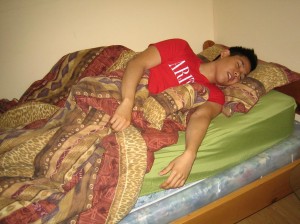Shin splints are pain that is felt along the front of the lower leg or shin bone. The pain is felt in the inferior region of the leg amidst the knee and the ankle.
Shin splints are common injuries in sports that happen due to overexerting of the body during running exercises. It usually affects people engaging in moderate to heavy physical activities and stop-start sports such as racquetball, soccer, tennis and basketball. Sometimes it becomes severe that there is a need to stop the activities.
Shin splint is also a cumulative or increasing stress disorder such as recurring pounding and strain on the muscles, bones and joints in the inferior legs. It prevents the body from naturally recuperate.
Causes of shin splints
- Excessive force placed on the shin bone and adjacent tissues that are connected to the muscles that surround the area.

Take plenty of rest. Avoid performing workout routine while still in the healing stage for fast healing of the condition. - Swelling, pain and inflammation of the muscles
- Stress reactions to fractures of bone
Symptoms
- Pain can be felt during performing exercises
- A dull ache in the front area of the lower leg
- Muscle pain
- Pain on either side of the shin bone
- Numbness and weakness in the feet
- Swelling in the lower leg usually mild
- Tenderness or soreness along the inner area of the lower leg
Treatment
- Take plenty of rest. Avoid performing workout routine while still in the healing stage for fast healing of the condition. Avoid running, sprinting or walking fast. Perform low-impact exercises such as swimming or biking.
- Apply ice on the affected area. Place ice cubes in plastic bag and then applies to the shins for at least 20 minutes intervals.
- Take the prescribed over-the-counter medications such as naproxen, ibuprofen or aspirin to lessen the pain and the inflammation.
- Perform gentle stretching in the morning for the shins to prevent making the area stiff and for fast healing of the condition. Perform a stair stretch by standing on a step or a stair; let the toes hang over the edge. Point the toes downward, and then stretch the toes toward the ceiling. Repeat this exercise for at least 20 times, rest for a few seconds and then repeat again for 20 times.
Tips
- Take proper warm up before sprinting, running or playing sports such as basketball and soccer that needs plenty of heaving footwork. Walk briskly at least a block or two before running or perform a light one-mile jogging before running for longer miles.
- Perform workouts on soft surfaces such as dirt paths or grass instead of the road or the sidewalk.
